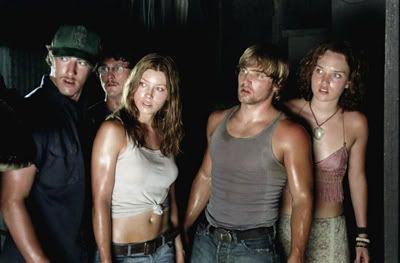Horrorthodoxy
Over the last few years, I have been pretty much universally disappointed with the horror fare making its way across the screens of the American Multiplex. It shouldn’t be surprising to me Most of the iconic horror that I can think of came out of the minds and pockets of smaller visionaries who were forced (by budget) into the arms of invention.
What troubles me most about big budget horror is not the table scrap remakes, inflated pseudo-auteurs (R.Zombie, Eli Roth), or even the babe of the week casting phenomenon. All of this is irksome, but not nearly as much as the uniformity of images. The lighting is particularly bad (read: overly good) in things like P-2, Prom Night, and the Saw films.
Catherine Breiallt (dir. Fat Girl, Romance) has often mused about the difficulty of getting authentic portrayals out of seasoned actors. She maintains that after too much time in front of the camera the performer often becomes a craftsman who is married to their process rather than an artist on a journey of discovery. Why should anything be different with technical professionals within the industry? Most DP’s and directors have an aesthetic standard well engrained in them by the time they reach their positions. There are still a myriad of choices on how to light and lens a film. But as a new cinematographer or first time director, choosing to underexpose a face, eschew a backlight, or unconventionally frame an actor is probably a good formula for not getting hired again.
Why should technically great filmmaking be a problem? It’s not; it’s the predictability with which the rules are set and applied that creates the mediocrity we bemoan. That is why indie horror is so much more interesting to many of us. Shooting styles and cutting styles can be tinkered with to ramp up tension and amplify the effect, with little or no risk to reputation.
The films that many of us consider classics of the genre do not look the same. TCM does not look like Halloween which doesn’t look like Friday the 13th. While not everything can be new; and a well-crafted film can be a joy to watch; a risk-taking film that doesn’t hit all its notes can be equally fun and much more inspiring. Cannibal Holocaust comes to mind.
“Though marred by thin, washed out color, (the) pic otherwise has a professional look, with skillful and frequent use of dolly shots for atmospheric effect. Sharp sense of composition and careful accumulation of detail also help enliven the crude plot, and the acting is above par for this type of film.”- Original Variety review of “The Texas Chainsaw Massacre” (1974)
The review excerpt above is proof that not everyone, even a seasoned eye will understand what is trying to be conveyed. What would ‘Chainsaw be with a crisp appearance and a more polished, detailed plot maybe…

So what are the films in my recent memory (last 20 years), that have gone outside of accepted norms in technical proficiency or story device to perhaps blaze a trail for the future. Oddly enough, for me most of them fall outside of the horror genre. “28 Days Later” and “The Blair Witch Project” are there, of course. But so too are things like Michael Haneke’s “Funny Games” (Austrian version) and “The Seventh Continent”, Gaspar Noe’s “Irreversible”, Douglas Buck’s “Family Portraits”, Jorg Buttgereit’s “Der Todes King”, Martina de Van’s “In My Skin” and Takashi Miike’s “Audition” among others give me hope that horror/extreme cinema will continue to push forward into new ways of telling, shooting, or cutting stories.
What are some films that have forced you to redefine your horror tastes and what you expect from the genre?

